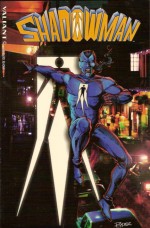
By Steve Ditko, Steve Englehart, Jim Shooter, Bob Hall, David Lapham & various (Valiant)
No ISBN
The 1990s were a slow period in terms of comics creativity: the industry had become infested with collector/investors and was increasingly market-led, with spin-offs, fad-chasing, shiny gimmicks and multiple-covers events replacing imagination and good story-telling in far too many places. One notable exception was a little outfit with some big names that clearly prized the merits of well-told stories illustrated by artists immune to the latest mis-proportioned, scratchy poseur styles, but one with enough business sense to play the industry at its own game.
Eschewing most of the more crass profiteering stunts Valiant revived some old characters and proved once more that the basics never go out of fashion. As Editor-in-Chief, Jim Shooter had made Marvel the most profitable and high-profile they had ever been, and after his departure he used that writing skill and business acumen to transform some almost forgotten Silver-Age characters into contemporary gold.
Western Publishing had been a major player since comics’ earliest days, blending a huge tranche of licensed titles with a few home-grown heroes like Brain Boy, Turok, Son of Stone and M.A.R.S. Patrol Total War (created by Wally Wood). The company’s most notable stars were Dr. Solar, Man of the Atom and Russ Manning’s magnificent science fiction cautionary tale Magnus, Robot Fighter. When the parent company closed its original comic division in 1984 these masterful sagas soon faded from comic fans’ memory.
As the 1990s opened and with an agreement to revive some, any or all of these four-colour veterans, Shooter and co-conspirator Bob Layton came to a bold decision and made those earlier adventures part-and-parcel of their refit: acutely aware that old fans don’t like having their childhood favourites bastardized, and that revivals need all the support they can get. Thus the old days were canonical: they “happened†and the new company was off and running with an interested, older fan-base already in place.
But the upstarts were not content to simply revive and retrofit past glories: a growing legion of new characters was gradually added to the pantheon. One such was a Voodoo-tainted, New Orleans based wild man daredevil named Jack Boniface – Shadowman.
After a truly seminal cameo in X-O Manowar #4 musician Boniface was properly introduced in 1992 his own title. Shadowman premiered with ‘Jazz’, written by Shooter and Steve Englehart, illustrated by David Lapham and Joe Rubinstein.
The credits are a lot more complex that they might appear. Shooter famously used a communal brainstorming system to create characters and stories. The full credits for the graphic novel under review – gathering issues #1-3 and 6 (the un-included chapters being part of the company’s first braided cross-over event Unity) of the first Shadowman run read Plotters: Steve Ditko, Mark Moretti Don Perlin & Shooter, Writers: Englehart, Bob Hall, Faye Perozich, Shooter, Pencillers: Ditko, Lapham, Moretti and Inkers Charles Barnett III, Gonzalo Mayo, Rubinstein & Tom Ryder.
In that eerie introduction Boniface was a struggling session saxophonist trying to strike it rich in the Big Easy when he was seduced by Lydia, a mysterious woman he picked up in a club. Her sinister, trysting assault left him unconscious, amnesiac and forever altered by a bite to his neck. Unknown to Jack, Lydia was an agent of the Spider Aliens who form a covert keystone of the Valiant Universe, preying on humanity for millennia and responsible for creating many of the paranormal humans who secretly inhabit the world.
Alone in the morning light Boniface discovered that Lydia’s home was filled with half-digested corpses. Clearly he was to be her next meal – but now has no idea how he survived or where she went. He cannot conceive of how her bite has altered him…
He flees but later as darkness falls he feels agitated, restless, aggressive: he roams the streets and finds himself drawn back to Lydia’s home and stumbles upon a voodoo sacrifice. Attacked by the priest the once docile musician dons a Mardi Gras mask found at his feet and fights back with brutal abandon. Lydia’s has somehow turned him into a violent driven maniac, hungry for conflict – but only when the sun goes down…
In ‘Spirits Within’ (Perozich, Shooter, Lapham & Ryder) Jack’s own hunger for answers takes him to both experts in medicine and Obeah magic before his Shadowman self drags him into a confrontation with a Bayou axe murderer, whilst ‘The Beast and the Children’ (Perozich, Moretti & Barnett III) finds the increasingly off the rails music-man tackling mobsters and hit-men before destroying a well-connected super-powered child abuser.
There’s a big change in the character seen in the fourth and final tale here. It begins with Shadowman’s return from the far future and a distant dimension where the combined Valiant heroes experienced “Unityâ€. Whilst there Boniface fell in love and learned exactly when he would die…
Written by Shooter, Ditko, Don Perlin and Moretti with art by Ditko, Moretti and Gonzalo Mayo ‘The Family That Slays Together’ pitted the Shadowman against a murderous clan of degenerate swamp-dwellers stealing women and children from local communities. Bitter, merciless and now completely reckless since he believes he cannot die – yet – Shadowman had become a relentless, remorseless, punishing force of nature. What a pity Jack Boniface was a helpless witness to everything his night-self did…
Combining the best elements of conflicted lone vigilantes and dark avengers such as Batman and Daredevil with an exotic locale and traditional horror elements, Shadowman offers a tense, dark underbelly to the super-science and shining heroism of Valiant’s other titles, and despite the committee-like nature of its creation still delivers heaping helpings of moody mystery and arcane excitement. Well worth reviving and definitely a different action hero you will love to read…
© 1994 Voyager Communications Inc. All rights reserved.
